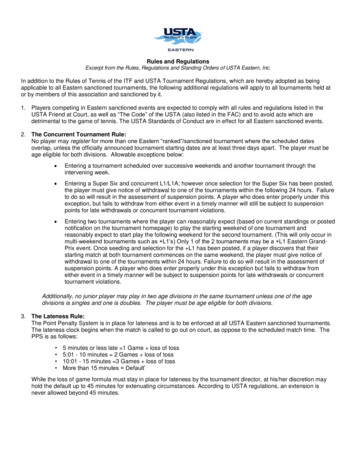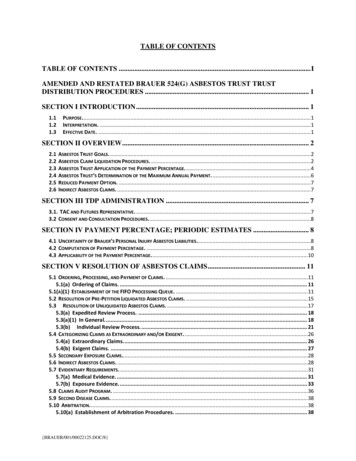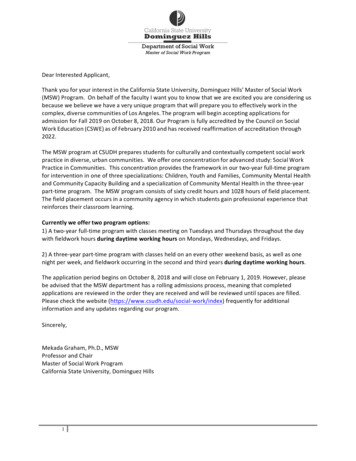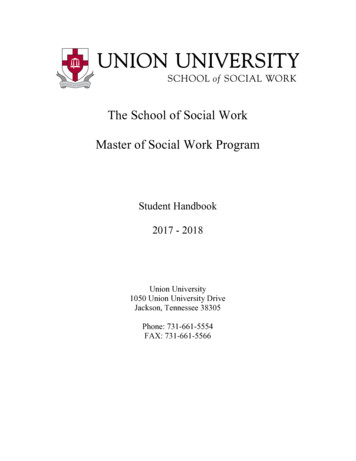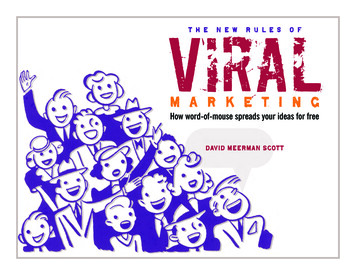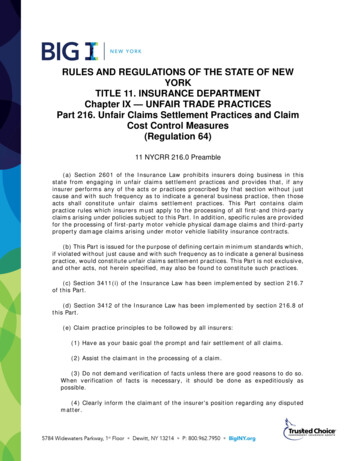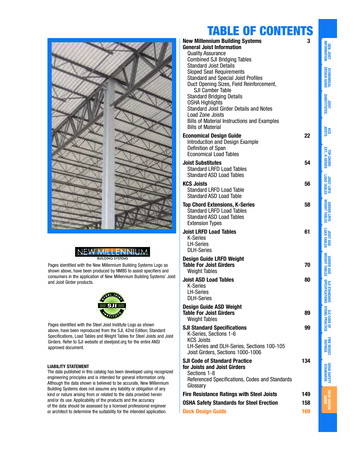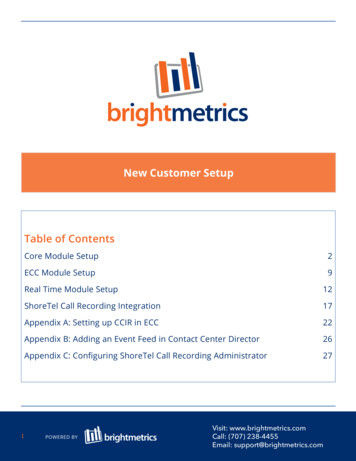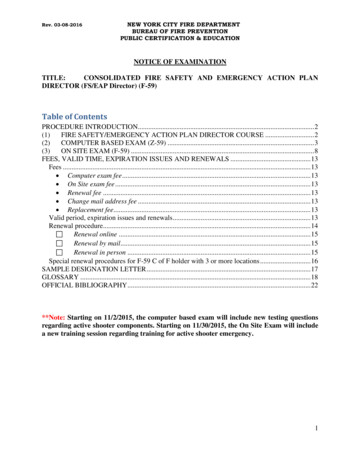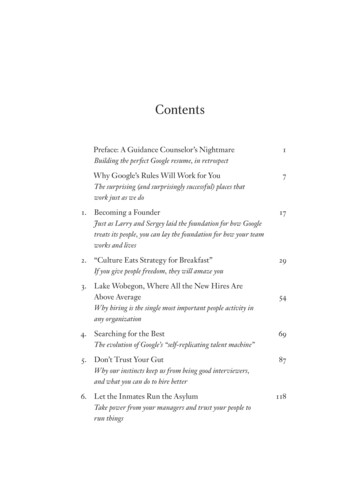
Transcription
ContentsPreface: A Guidance Counselor’s Nightmare Building the perfect Google resume, in retrospect1Why Google’s Rules Will Work for You The surprising (and surprisingly successful) places thatwork just as we do71.Becoming a Founder Just as Larry and Sergey laid the foundation for how Googletreats its people, you can lay the foundation for how your teamworks and lives172.“Culture Eats Strategy for Breakfast” If you give people freedom, they will amaze you293.Lake Wobegon, Where All the New Hires AreAbove Average Why hiring is the single most important people activity inany organization544.Searching for the Best The evolution of Google’s “ self- replicating talent machine”695.Don’t Trust Your Gut Why our instincts keep us from being good interviewers,and what you can do to hire better876.Let the Inmates Run the Asylum Take power from your managers and trust your people torun things118vii 11/5/14WorkRules HCtext3P.indd12:27:46 AM
viii Contents7.Why Everyone Hates Performance Management, andWhat We Decided to Do About It Improve performance by focusing on personal growthinstead of ratings and rewards1508.The Two Tails The biggest opportunities lie in your absolute worst andbest employees1789.Building a Learning Institution Your best teachers already work for you. . . . Let them teach!20410.Pay Unfairly Why it’s okay to pay two people in the same job completelydifferent amounts22511.The Best Things in Life Are Free (or Almost Free) Most of Google’s people programs can be duplicated by anyone26012.Nudge . . . a Lot Small signals can cause large changes in behavior. How oneemail can improve productivity by 25 percent28313.It’s Not All Rainbows and Unicorns Google’s biggest people mistakes and what you can do toavoid them31814.What You Can Do Starting Tomorrow Ten steps to transform your team and your workplace336Afterword for HR Geeks Only: Building theWorld’s First People Operations Team The blueprint for a new kind of HR349Work Rules 367Acknowledgments 371Photo Credits 375Notes 377Index 397About the Author 405WorkRules HCtext3P.inddviii 11/5/1412:27:46 AM
Preface: A Guidance Counselor’sNightmareBuilding the perfect Google resume,in retrospectMy first paycheck came in the summer of 1987, when Iwas fourteen years old. My best friend, Jason Corley,and I had been invited by our high school to enroll ina s ummer- school debate class the year before ninth grade. By thenext year, we were teaching it. We earned 420 each.Over the next twenty-eight years, I amassed a random walkresume that could best be described as a guidance counselor’snightmare: I worked in a deli, a restaurant, and a library. I tutoredhigh school students in California and taught elementary schoolstudents English in Japan. I was first a lifeguard in real life at mycollege pool, and then I played one on TV, appearing on Baywatch asa 1960s lifeguard in a flashback and as that old acting standby, “Manwalking across background.” I helped start a nonprofit that sup‑ported troubled teens, and worked at a manufacturer that built con‑struction products. I stumbled into consulting on executive pay, andwith all the wisdom a t wenty- four- year- old can muster, observedthat human resources was a stagnant field and fled to get an MBA.Two years later I joined McKinsey & Company, the managementconsulting firm, where I focused as little on people issues as I could.During the dot- com boom years up until early 2000, I advised tech‑nology companies on how to grow sales, users, and organizations.And when the bubble popped, I advised technology companies onhow to slash costs, run efficiently, and pivot into new businesses.WorkRules HCtext3P.indd1 11/5/1412:27:46 AM
2 Work Rules!But by 2003 I was frustrated.Frustrated because even the b est- designed business plans fellapart when people didn’t believe in them. Frustrated because lead‑ers always spoke of putting people first, and then treated them likereplaceable gears. (Low point on my first project: I asked my man‑ager for career advice and he told me, “You guys are all like arrowsin a quiver. Every one of you is the same.”)I’d held blue- collar jobs and white- collar jobs, been paid mini‑mum wage and a s ix- figure salary, toiled alongside— and been man‑aged by— people who didn’t finish high school and people with PhDsfrom the poshest universities in the world. I had worked in an envi‑ronment where our sole purpose was to change the world, and anotherwhere it was all about profits for the owner. It just didn’t make senseto me that no matter where I turned, people weren’t treated better intheir jobs. You spend more time working than doing anything elsein life.1 It’s not right that the experience of work, even at some of thebest employers, should be so demotivating and dehumanizing.I determined that I had two paths to choose from. The firstwas to treat my teams better, improve their output, and hope thatover time others would follow my example. The second was to finda way to influence how entire companies treat people. I chose thelatter path because I believed it would give me the greatest chanceof affecting the most people, and decided to find a job in humanresources (HR). My colleagues in consulting thought I was commit‑ting professional suicide, but I’d done my homework. At the time,there were more than five thousand people in McKinsey’s databaseof alumni, but only a hundred of them were in human resources,virtually all working as consultants for other firms or recruiters. Ireasoned that my training and background would make me standout in the HR talent pool and help me come up with novel solutionsto people. And maybe, just maybe, that would help me have a fastercareer trajectory than waiting twenty or thirty years to creep up theWorkRules HCtext3P.indd2 11/5/1412:27:46 AM
Preface: A Guidance Counselor’s Nightmare 3corporate ladder. I might get to a place where I could impact morepeople, faster.I wanted to work at the places where I could learn as much aspossible about HR, and Pepsi and General Electric were the b est- regarded HR shops at the time. I c old- called eight HR executivesfrom the two companies, but only one, Anne Abaya at GE, returnedmy call. Anne, a fluent Japanese speaker from Hawaii who somehowwas always able to carve out a few minutes here and there to helppeople, found my background intriguing and introduced me to oth‑ers at GE.Six weeks later, I was hired. I was now the Vice President ofCompensation and Benefits of the Commercial Equipment Financ‑ing division of the GE Capital division of the General ElectricCompany. I was thrilled to be there, though my friends took onelook at my business card and thought I was nuts. My first boss,Michael Evans, gave me tremendous latitude to explore the com‑pany and helped me understand GE’s approach to talent.People mattered to Jack Welch, GE’s chairman and CEO from1981 to 2001. He spent more than 50 percent of his time on peopleissues,2 and together with Bill Conaty, his chief human resourcesofficer, built an acclaimed people management system by strin‑gently ranking employees based on performance, choreographingjob changes for top talent every twelve to eighteen months, andbuilding a global training center in Crotonville, New York. Jack hadhanded over the reins to a new CEO, Jeff Immelt, two years beforeI joined, which allowed me to see what had been built and how itchanged as Immelt’s focus shifted to other areas.Welch and Conaty had implemented a 20- 70- 10 performanceranking system, where GE employees were sorted into threegroups: the top 20 percent, the middle 70 percent, and the bottom10 percent. The top workers were lionized and rewarded with choiceassignments, leadership training programs, and stock options. TheWorkRules HCtext3P.indd3 11/5/1412:27:46 AM
4 Work Rules!bottom 10 percent were fired. Under Immelt, the forced distribu‑tion was softened and the crisp labels of “top 20 percent,” “middle 70percent,” and “bottom 10 percent” were replaced with euphemisms:“top talent,” “highly valued,” and “needs improvement.” Colleaguestold me that the vaunted Session C process, a yearlong review of tal‑ent across the 300, 000- person- strong company, had “lost its teeth”and “just wasn’t the same without Jack’s focus.” 3I didn’t have the benefit of having worked under both CEOs,but it dawned on me how deeply a CEO’s persona and focus canshape an institution. Most CEOs are very good at many things, butthey become CEOs for being superbly distinctive at one or two,which tend to be matched to a company’s needs at that time. EvenCEOs need to declare a major. Welch is best known for Six S igma— a set of tools to improve quality and e fficiency— and his focus onpeople. Immelt instead emphasized sales and marketing, most vis‑ibly through GE’s branded “ecomagination” efforts to make and beperceived as a maker of greener products.In 2006, after three years at GE, I was recruited to join Googleas head of People Operations. I remember the recruiter, MarthaJosephson, trying to convince me not to wear a suit to the interview.“No one wears suits,” she assured me, “and they’ll think you don’tunderstand their culture if you show up in one.” I took her advice,but was skeptical enough that I carried a necktie stuffed into myjacket pocket in case I needed it. Years later, I’d interview a candi‑date who had clearly purchased a beautiful pinstripe suit just for theinterview, but who was still so exceptional that I could tell we’d hirehim. I closed the interview with, “Brian, I have good news and badnews. The good news is that, while you still have more interviews togo, I can tell that you’re going to get an offer. The bad news is thatyou’re never going to get to wear that suit again.”When I joined, it was two years after Google’s initial publicoffering: Revenues were growing 73 percent a year; Gmail had justlaunched with an unheard‑of free gigabyte of storage (five hun‑WorkRules HCtext3P.indd4 11/5/1412:27:46 AM
Preface: A Guidance Counselor’s Nightmare 5dred times more than prior webmail s ervices— this was so crazythat people thought Gmail was an April Fool’s joke)4; there were sixthousand Google employees and the company wanted to double insize every year; and they had this wildly ambitious mission to orga‑nize the world’s i nformation— all of it!— and make it universallyaccessible and useful.This mission for me was by far the most exciting part. I wasborn in 1972 in Communist Romania, a country ruled by the dicta‑tor Nicolae Ceausescu and permeated by secrecy, lies, and fear. It’shard to conceive of today, but Romania at the time was much likeNorth Korea today. Friends and family members would disappearfor criticizing the government. Members of the Communist Partyhad access to fine clothes, consumer goods, and fruit and vegetablesfrom the West, while my parents didn’t taste their first banana untilthey were in their thirties. Children were encouraged to spy ontheir parents. And the newspapers and radio disseminated little butlies about how great the government was and how evil and oppres‑sive the United States was. My family fled Romania seeking free‑dom, the right to go where they wanted, say and think what theywanted, associate with whomever they wanted.The idea of joining a company founded with a goal of makinginformation available to everyone was thrilling, because the stateof freedom is predicated on free expression, which in turn relies onaccess to information and truth. I’d lived and worked in all kindsof environments and seen lots of examples of what didn’t work. Ifthis place is for real, I thought, this is going to be the best job in theworld.Since I joined, Google has grown from six thousand employeesto almost fifty thousand, with s eventy- plus offices across more thanforty countries. Fortune has named Google the “Best Company toWork For” an unprecedented five times in the United States, aswell as numerous times in countries as diverse as Argentina, Aus‑tralia, Brazil, Canada, France, India, Ireland, Italy, Japan, Korea,WorkRules HCtext3P.indd5 11/5/1412:27:46 AM
6 Work Rules!the Netherlands, Poland, Russia, Switzerland, and the UK. Googleis the most sought- after place to work on the planet according toLinkedIn,5 and we receive about two million applications everyyear, representing individuals from every background and part ofthe world. Of these, Google hires only several thousand per year,6making Google t wenty- five times more selective than Harvard,7Yale,8 or Princeton.9Far from being professional suicide, my time at Google hasbeen a white- water ride of experimentation and creation. Some‑times exhausting, sometimes frustrating, but always surging for‑ward to create an environment of purpose, freedom, and creativity.This book is the story of how we think about our people, what we’velearned over the past fifteen years, and what you can do to put peo‑ple first and transform how you live and lead.WorkRules HCtext3P.indd6 11/5/1412:27:46 AM
Why Google’s Rules Will Workfor YouThe surprising (and surprisingly successful)places that work just as we doA billion hours ago, modern Homo sapiens emerged.A billion minutes ago, Christianity began.A billion seconds ago, the IBM personal computer was released.A billion Google searches ago . . . was this morning.— Hal Varian, Google’s chiefeconomist, December 20, 2013Google turned sixteen years old in 2014, but became partof the fabric of our lives long before. We don’t search forsomething on the Internet, we “Google it.” More thana hundred hours of video is uploaded to YouTube every minute.Most mobile phones and tablets rely on Google’s free, open- sourceioperating system, Android, which didn’t exist in the market before2007. More than fifty billion apps have been downloaded from theGoogle Play store. Chrome, launched as a safer, faster, and open- source Web browser in 2008, has over 750 million active users andhas grown into an operating system poweri
Why Google’s Rules Will Work for You 7 The surprising (and surprisingly successful) places that work just as we do 1. Becoming a Founder 17 Just as Larry and Sergey laid the foundation for how Google treats its people, you can lay the foundation for how your team works and

